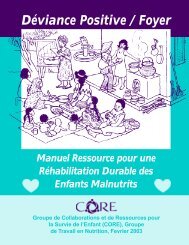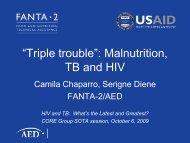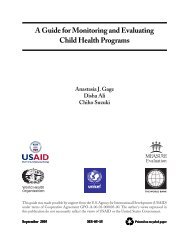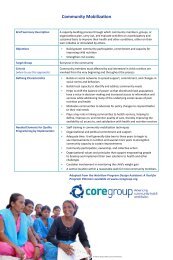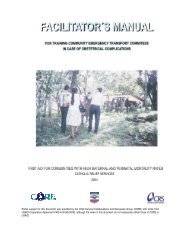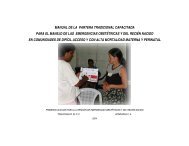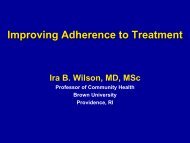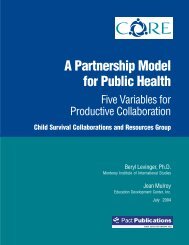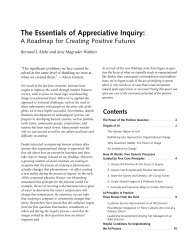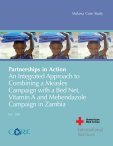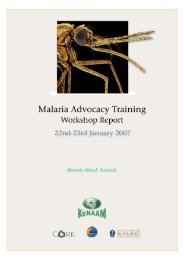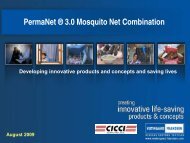Partnership Defined Quality Technical Advisory ... - CORE Group
Partnership Defined Quality Technical Advisory ... - CORE Group
Partnership Defined Quality Technical Advisory ... - CORE Group
You also want an ePaper? Increase the reach of your titles
YUMPU automatically turns print PDFs into web optimized ePapers that Google loves.
<strong>Partnership</strong> <strong>Defined</strong> <strong>Quality</strong> <strong>Technical</strong> <strong>Advisory</strong> <strong>Group</strong> MeetingSaturday, June 27, 2009 12:00 pm - 5:00 pmSave the Children office, Westport, CTBackgroundThis report documents the discussions, decisions and products of the <strong>Partnership</strong> <strong>Defined</strong><strong>Quality</strong> (PDQ) <strong>Technical</strong> <strong>Advisory</strong> <strong>Group</strong> (TAG), led by Save the Children staff on June27, 2009. This was the second annual global TAG meeting held on PDQ.Most of the 14 participants were SC staff from WWO or from Country Offices; howeverrepresentatives from AMREF and Project Hope also attended. Participants were asked tobring to the meeting any information on scope of their PDQ activities, accomplishmentsof QITs, any baseline or endline data, and list of indicators being measured through PDQ.<strong>Partnership</strong> <strong>Defined</strong> <strong>Quality</strong> is a methodology to improve the quality and accessibility ofservices with community involvement in defining, implementing, and monitoring thequality improvement process. <strong>Partnership</strong> <strong>Defined</strong> <strong>Quality</strong> (PDQ) links qualityassessment and improvement with community mobilization. Save the Children (SC)developed and tested the <strong>Partnership</strong> <strong>Defined</strong> <strong>Quality</strong> methodology in 1996 in response tolearning that providers and communities had different definitions and priorities forquality of care. The methodology was expanded and piloted in Nepal, Peru, Haiti,Pakistan, Azerbaijan, the West Bank Gaza, Georgia and Ethiopia. In 2002 Save theChildren published the PDQ Manual: a toolbook for community and health providercollaboration for quality improvement.In 2003, <strong>CORE</strong> <strong>Group</strong> issued a Request for Proposals to its member organizations forpromising child health innovations that could benefit a larger audience if they werediffused beyond the originating organization. There were several criteria for successfulproposals, including the relevance to multiple country and cultural situations and theevidence of effectiveness. SC won a Diffusion of Innovation award to expand the PDQmethodology. As part of this award, SC developed the PDQ Facilitators Guide,conducted a training at the <strong>CORE</strong> Spring Meeting and held a Training-of-Trainersworkshop in Bangkok, Thailand for participants from eleven countries and eight differentorganizations.In 2007, Save the Children and the Social and Behavior Change (SBC) Working <strong>Group</strong>within <strong>CORE</strong> <strong>Group</strong> identified the need to assess and learn from PDQ applications todate in order to further improve the quality and scale of the approach. During that year,PDQ practitioners within SC held a small workshop in Armenia to discuss progress andlearning in the region, share methods for monitoring and evaluation and discuss issuesrelated to sustainability and scale. SC, together with the SBC Working <strong>Group</strong> from<strong>CORE</strong> sent out a questionnaire to various list serves and email lists, seeking PDQpractitioners. The resulting list included responses from over 15 countries and 4implementing organizations. In-depth key informant interviews were conducted with sixrespondents to develop a more detailed understanding of their process the lessonslearned.
The first PDQ TAG meeting was held in May 2008, providing an opportunity forpractitioners from over 15 countries to share successes and challenges, list elementsthat maximized success, and discuss strategies for documenting and sharing PDQexperiences in the future. Issues raised include the sustainability of both <strong>Quality</strong>Improvement Teams (QITs) and quality improvements, indicators for PDQ and howPDQ, as a quality improvement tool, can promote behavior change and social change.Results of that meeting included the completion of 11 monographs of PDQexperiences as well as a document entitled: Key Elements for Maximizing theEffectiveness of PDQ.In December 2008, Save the Children completed an adaptation of the PDQ manualfor youth, entitled: <strong>Partnership</strong> <strong>Defined</strong> <strong>Quality</strong> for Youth: a Process Manual forImproving Reproductive health Services through Youth-Provider Collaboration.Training workshops for youth programming since then have taken place in Ethiopiaand Bangladesh.As projects continued and results in use of PDQ were emerging, the need was felt toconvene another meeting in order to continue the dialogue among practitioners toshare successes and challenges, but also to seek better ways of measuring qualityimprovement within PDQ. This has traditionally been difficult, since PDQ sembedded within larger projects with broader indicators. Daft monitoring andevaluation tools developed in Pakistan were then compiled into a draft toolkit. At thesame time, Save the Children was developing indicators for measuring communitycapacity. Additionally there was a concern that PDQ expertise needed to bemaintained regionally. The PDQ TAG meeting which took place on June 27, 2009thus had several ambitious objectives• To share progress and challenges in PDQ among our country programs• To review WHAT we are measuring when evaluating PDQ• To discuss HOW we are measuring it• To determine how we can strengthen both what we are measuring and how• To decide on a strategy for building regional technical capacity in PDQPlease note that there are three attachments to this report:1. Participant list and meeting agenda (attached at the end of this document)2. A zip drive with draft PDQ monitoring tools that were discussed and revised at theTAG3. The Community Capacity Indicators that were reviewed during the meeting withcomments in red4. Powerpoint presentations from Kenya, Pakistan, as ( as well as from Bolivia andArmenia which were shared at Health meeting for SC the following week)Notes from the PDQ TAG meeting June 27, 2009After introductions, two country (Kenya and Pakistan) program representatives providedbrief updates on their PDQ activities and accomplishments.
Kenya - AMREFBill Yaggy from AMREF provided an update on the use of PDQ in Kenya which resultedin some successes. These included:• The community started paying fees to go to the health center when they realizedthat these funds were needed in order to improve the services for them• Water was now available in the health facility• Better maintenance of the yard around the health facility where women wouldgather for their prenatal or well-baby exams.accomplishments• Improved HW attitude, and improved perceptions toward HWs improved• Higher attendance• higher HF income• Better allocation of resources through QIT advocacy– District provided funds to repair water system– HF committee reallocated funds to pay to maintain and run generator, and– To pay CHWs to take on some routine tasks at HF to free up professionalsto see patientsChallenges• Mobilizing resources to execute action plans with huge costs (e.g. ambulance)• Poor attendance at regular QIT planning, monitoring and review meetings• Creation of new district - new DHMT did not understand need for PDQ• Established health facility committees see QIT as a threatLessons Learned• PDQ approach was successful at one HF where entire process was completed• Projects need to plan and budget adequately for PDQ• Joint planning, implementation, monitoring, and review helps to overcomecommunication barriers between providers and clientsAlthough PDQ was successful in improving one facility and overall was seen to beeffective there, it was a very time consuming process.. Costs for PDQ were difficult toseparate from costs for the larger project because data for the HFA and MNCHassessment were not budgeted separately in the outset of the project.Pakistan – Save the ChildrenDr. Amanullah Khan from SC Pakistan also shared preliminary results from the use ofPDQ as part of the national maternal and newborn health project, entitled PAIMAN. Thisproject encouraged community mobilization support of the Lady Health Workers(LHWs) and use of male committees to promote the household to hospital continuum ofcare. Media events promoted messages of health seeking behavior and overall awarenessabout the issues.Accomplishments• increase in the number of outpatient clients in the district of Khaniwal in PDQversus non PDQ communities• Increase in the number of ANC clients Khaniwal
• Increase in number of children immunized• Increase in TT vaccinations• Exit interviews showed a significant different in client satisfaction especiallyregarding the cleanliness of the health facility in PDQ communities versus nonPDQ communitiesChallenges• Involving the least advantaged people and poor in a planning team requires lot ofefforts• Process is intensive and time consuming.• Frequent postings and transfers of health facility staff and district healthmanagersLessons Learned:• If the MOH could be engages to help lead the QITs, this will promotesustainability in the long term.• Strong facilitators are needed.• Sustainability needs to be instilled into the project from the very beginning. PDQneeds to be institutionalized within the government structures.• Support is needed over time to be able to ensure representation of themarginalized groups in the QITs.• No matter how tempting it may be, it is not beneficial to use shortcuts in the PDQprocess because valuable steps in community empowerment are lost.What are we Currently Measuring?The group then engaged in an exercise to think about what we are currently measuringthrough our PDQ implementation. Participants listed two indicators they currentlymeasure and then posted it under the appropriate column heading (choices were qualityimprovement, health outcomes --impact, behavior change, community capacity and“other.”Although we had different definitions of “quality improvement” and “outcomes,” we allagreed that there was very little being measure in the area of community capacity. SincePDQ generally is embedded within a larger project, the process indicator data issometimes measured, but when it is, there is very little measurement of the activitieswithin the QITs as they work to mobilize communities for social change. It is theincreases in capacity of the QIT with the support of the larger community that are thechanges which result in the achievement of items on action plans. The satisfaction (orempowerment) that communities feel as they realize that they do have resources andcapability to solve their own problems spurs them on to tackle other problems in thecommunities that are barriers to service and access. This internalized empowerment issustainable much beyond the life of the project.PDQ practitioners know that the process is effective intuitively and by the increase innumbers of clinic users. However few tools have been used to measure these changes andshow that they are not only significant but that they can be attributable to PDQ process.Further, there is no standardization to date about what such tools should look like not
how they should be shared and housed. With this aim, SC and it partners have beenattempting to compile M and E tools being used in PDQ implementation. In 2009, the SCPakistan country office developed a comprehensive set of tools which include• PDQ Pathway Diagram• Mapping tool for health facilities• Checklist for Analysis of PDQ Tools• Monthly Outcome Indicator Data form• Supervisory checklist for PDQ process• Supervisory Checklist for QIT function• Team Effectiveness Questionnaire• Exit interview• PDQ quarterly report form (optional)• PDQ Action Planning Table• PDQ Tracking TableThese tools were shared amongst TAG members to review and will be furtherreviewed before they are finalized. The idea is that once these tools are thoroughlyvetted, they will serve as a basic standard which can be modified as needed by PDQimplementers from any country or program context. This will build the evidence baseand also provide a standard reference by which programs can be measured. Thesetools will form part of a PDQ toolkit. Plans are also in place for this toolkit to bemodified as well for youth programming.Measuring Community CapacityAs a group we reviewed indicators and questions from the attached MeasuringCommunity Capacity indicators document developed by Save the Children. Our task wasto review each for its relevance to PDQ. Some of those areas that are relevant alreadyhave a corresponding question within the PDQ monitoring tools. Others require that aquestion be added to an existing tool or phase of PDQ. Some of the changes can bemonitored by the QITs themselves while others will need to be assessed from the outsideobservers and supervisors. One suggestion was to add to the tools in the PDQ toolkit anEquity ChecklistWe made changes to the list of domains and definitions (in red in the attached document).Additionally, we felt that the following were critical to be measured:• % of community contribution , $ and in-kind• # of barriers overcome. # of meetings facilitated. How can we capture a group’sinitiative or drive??• What is the different between community capacity and empowerment??• We could perhaps measure community contribution to problem solving• Measure $ contributions of the provider etc as compared to amount of moneyraised within the community.• Note: Community perception of ownership is very important and needs to bemeasured; need evidence that the plan is being implemented.
Gail Snetro-Plewman is the lead at Save the Children on the review of the communitycapacity indicators. She clearly explained the link between measuring communitycapacity and measuring quality improvement:The PDQ approach works to reach marginalized populations and address the underlyingcauses of health problems such as discrimination, social and economic, cultural andpolitical and organizational conditions through addressing the quality of health services.An integral part of this process involves providing community members and healthfacility providers with the skills and systemic support they need to improve health servicequality and access to these services.The PDQ process encourages and supports communities so that they can activelyparticipate in their own health and social change. Organizations using communityempowering approaches are now increasingly seeking how to measure and documentchanges at the community level (beyond measurable changes in individuals’ behaviorsand knowledge). Within the PDQ approach the definition of “community” applies to thatof the health facility providers, and those PDQ quality teams that are composed of bothcommunity members and providers.SC/US recognizes the need to measure community capacity (CC) because : (1) SC/USinvests heavily to achieve CC in nearly all community-based programming: (2) SC/US isa recognized leader in the allied process of community mobilization (3) case studiessuggest that CC helps communities sustain results and successfully confront other socialchallenges; and (4) SC/US fails to get due recognition for the CC that it facilitatesbecause there is no concise and accepted way to describe it, let alone quantify it.Through PDQ we have the opportunity to actually measure community capacity as wellas quality improvement. This can help us demonstrate empowerment of the communitywhich is more sustainable than just an improvement coming from the outside. We brieflyreviewed the domains and selected one that we all agreed would pertain to PDQ and needto be measured. Some domains, such as Community Participation and representation ofmarginalized groups (at QIT meetings) are already being measured with existing tools,but perhaps were not though of as community capacity indicators. Others can be easilyadded within tools such as the Supervisory checklist on QIT function. Still others mayneed to be added as we refine our needs.Building and Maintaining Expertise in PDQAlthough PDQ was developed by Save the Children, many other organization areutilizing the methodology. Most turn to Save the Children for technical assistance butoften we are not able to provide it due to a limited number of available experts. Our hopeis to have more regional/global experts from the many ongoing projects. Thus aquestionnaire was developed prior to this meeting to get a list of the current PDQexpertise across organizations and gauge the comfort level of those individuals in beingable to evaluate, train, and help adapt PDQ for other programs. Our hope is to use thisinformation to develop a low cost method to build global capacity in PDQ.
Results• Of the over 45 questionnaires were mailed out, 27 people responded. Tworankings were added by Debbie Fagan to try to summarize people’s experience inimplementing PDQ and their experience in evaluating PDQ. The questionnaireprovided more information about people’s implementation rather than evaluationexperience:• The staff responses were organized by regions since it was our hope to haveregional experts.• Although regionally we have staff that have implemented PDQ, many do notcurrently feel confident to be the PDQ expert and be able to train other andevaluate other programs. Providing the skills need to elevate their confidence is achallenge but would elevate the staff skills for all projects.• Of the three non-Save respondents, there is also a broad spectrum of expertise.The challenge is how to best collaborate with these experts.Our goal at this meeting was to review in aggregate the responses to the PDQ expertisequestionnaire and then decide on a capacity building strategy. The group concurred withthe following recommendation for increasing capacity of global PDQ experts:1. Use current and upcoming implementations and evaluations as an opportunity forlocal/regional staff to observe or be mentored. This would only require regionaltravel by the staff member but it would allow them to see the program orevaluation in action rather than via a TOT2. Develop more tools and protocols that would help a new “expert” feel moreconfident in performing a new task•Criteria for approval as an “expert” are that the person needs toi. Have been trained in PDQii. Needs to have implemented PDQ in their own cultural contextiii. Has experience applying PDQ in at least one other contextiv. Preferable also: skills in documenting and evaluating PDQ3. Keep a current global implementation map and make it available to all so thatthey know where and when PDQ programs are occurring4. Develop a strategy to work with our partner experts to collaborate in buildingPDQ expertise.Other comments:• We need to make sure that cost information from PDQ implementers isshared so that those writing proposals have an idea for how much tobudget for these activities (remembering that this includes the time of staffto implement the process)• AMREF offered their Africa training site as a location where PDQtraining could take place
Please note that since this meeting took place, a monitoring trip to Vietnam will now alsoinclude PDQ staff from Pakistan and possibly Indonesia in order to have increasedparticipation and learning from that experience.Attachment 1: Participant List and Meeting AgendaName Organization Country Email addressIren Sargsyan SC Armenia isargsyan@savechildren.orgArsenio SC Mozambique axavier@savechildren.orgXavierNeena Khadka SC Nepal Neena.khadka@savethechildren.org.npAmanullah SC Pakistan akhan@savechildren.orgKhanHa Thanh SC Vietnam binhht@savethechildren.org.vnBinhTelesphore SCAfrica t.kabore@sciug.orgKaboreRegionalStaniczai SC Afghanistan smansoor@savechildren.orgMansoorLudin Chavez SC El Salvador lchavez@savechildren.orgRuth Madison Project Hope Millwood VA rmadison@projecthope.orgBill Yaggy AMREF New York Yaggy@amrefusa.orgBrad Kerner SC Westport, CT bkerner@savechildren.orgBeth Outterson SCWashington boutterson@savechildren.orgDCEric Swedberg SC Westport, CT eswedberg@savechildren.orgKimSC Westport, CT kdonaldson@savechildren.orgDonaldsonRonnie Lovich SC Westport, CT rlovich@savechildren.orgAGENDA -- PDQ TAGSaturday June 27, 2009, 12:00-5:00 pmSave the Children Office, Westport, CTObjectives• To share progress and challenges in PDQ among our country programs• To review WHAT we are measuring when evaluating PDQ• To discuss HOW we are measuring it• To determine how we can strengthen both what we are measuring and how• To decide on a strategy for building regional technical capacity in PDQ12:00 -1:00 pm Lunch, welcome, introductions, meeting objectives and agenda for theday1:00-1:45 Brief updates on PDQ accomplishments• AMREF in Kenya (Bill Yaggy)
• SC in Pakistan (Dr. Aman)1:45 -2:00 Break2:00 - 2:30 What are we Measuring? (Exercise)2:30 - 2:45 – What should we be measuring that we are not?2:45 - 3:30 Review and Sharing of tools3:30 - 4:30 Measuring Community CapacityQuestions for discussion:• How do we capture the changes in community capacity that lead to sustainableoutcomes? (use of domains/capacity areas to guide indicator development)• Can we use/ adapt the work that is being done for the PDQ contextReview indicators and questions from CC (handout) for relevance to PDQ4:30 -5:00 Building capacity in PDQ• Review responses to PDQ expertise questionnaire• Decide on a capacity building strategy



